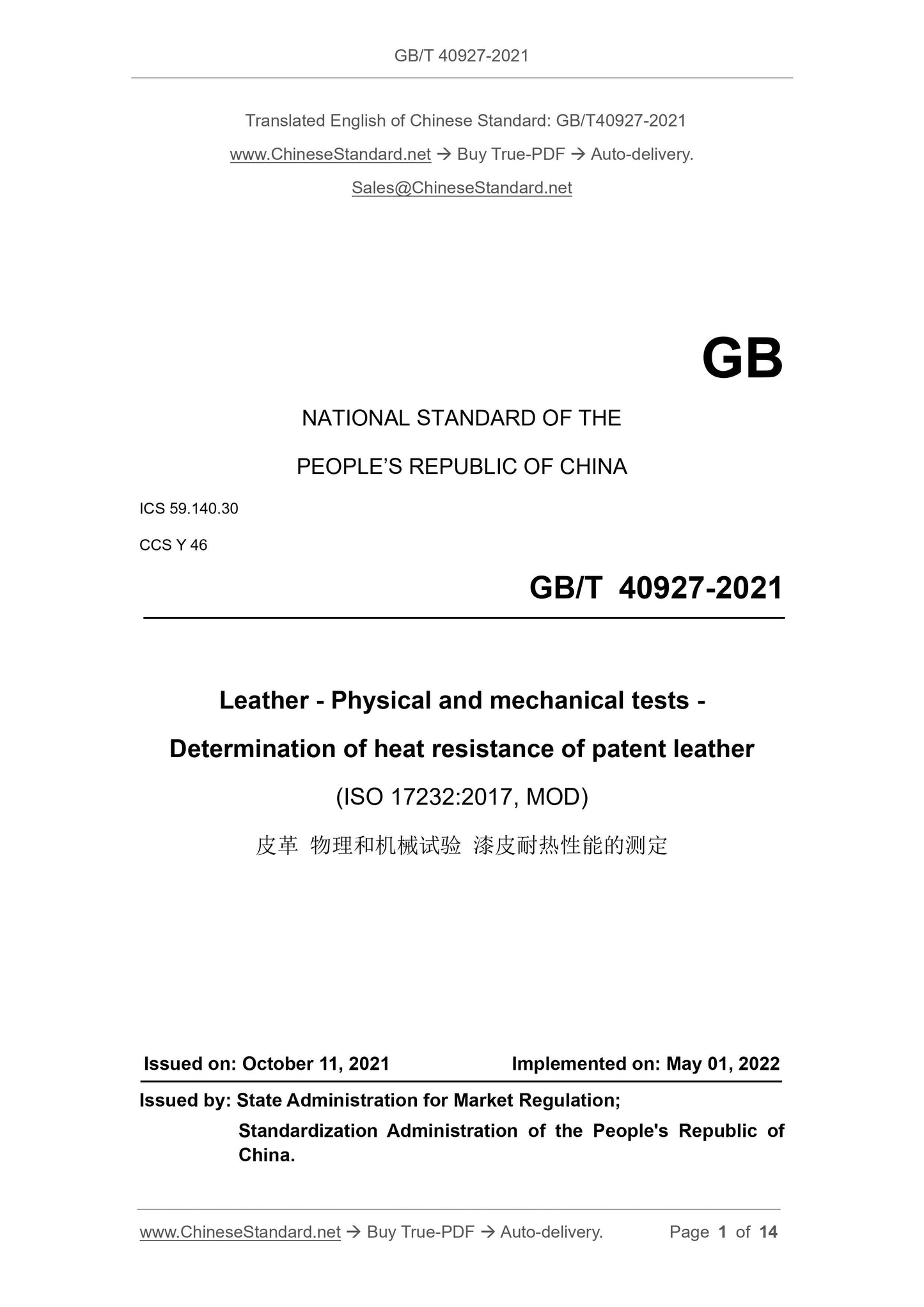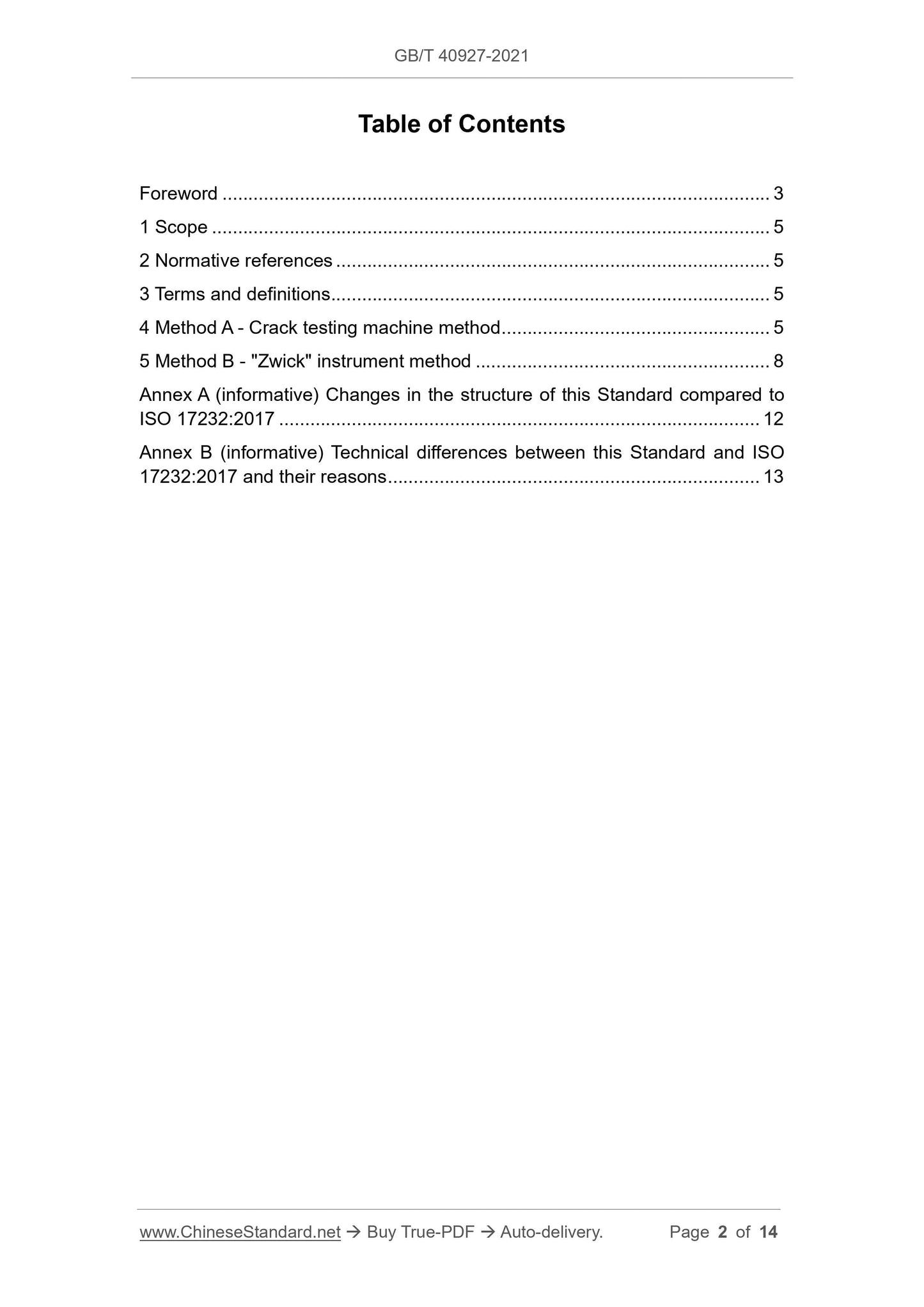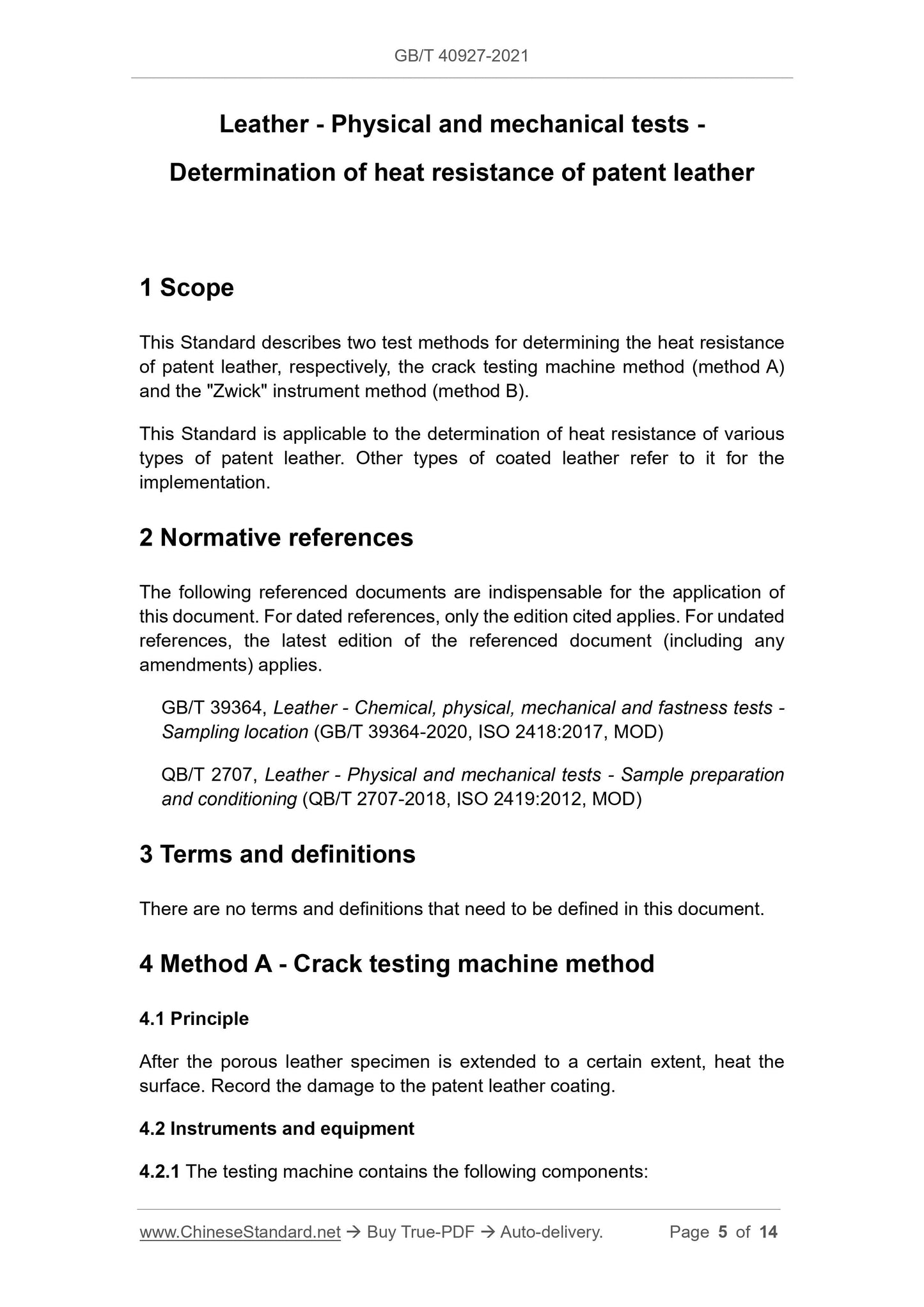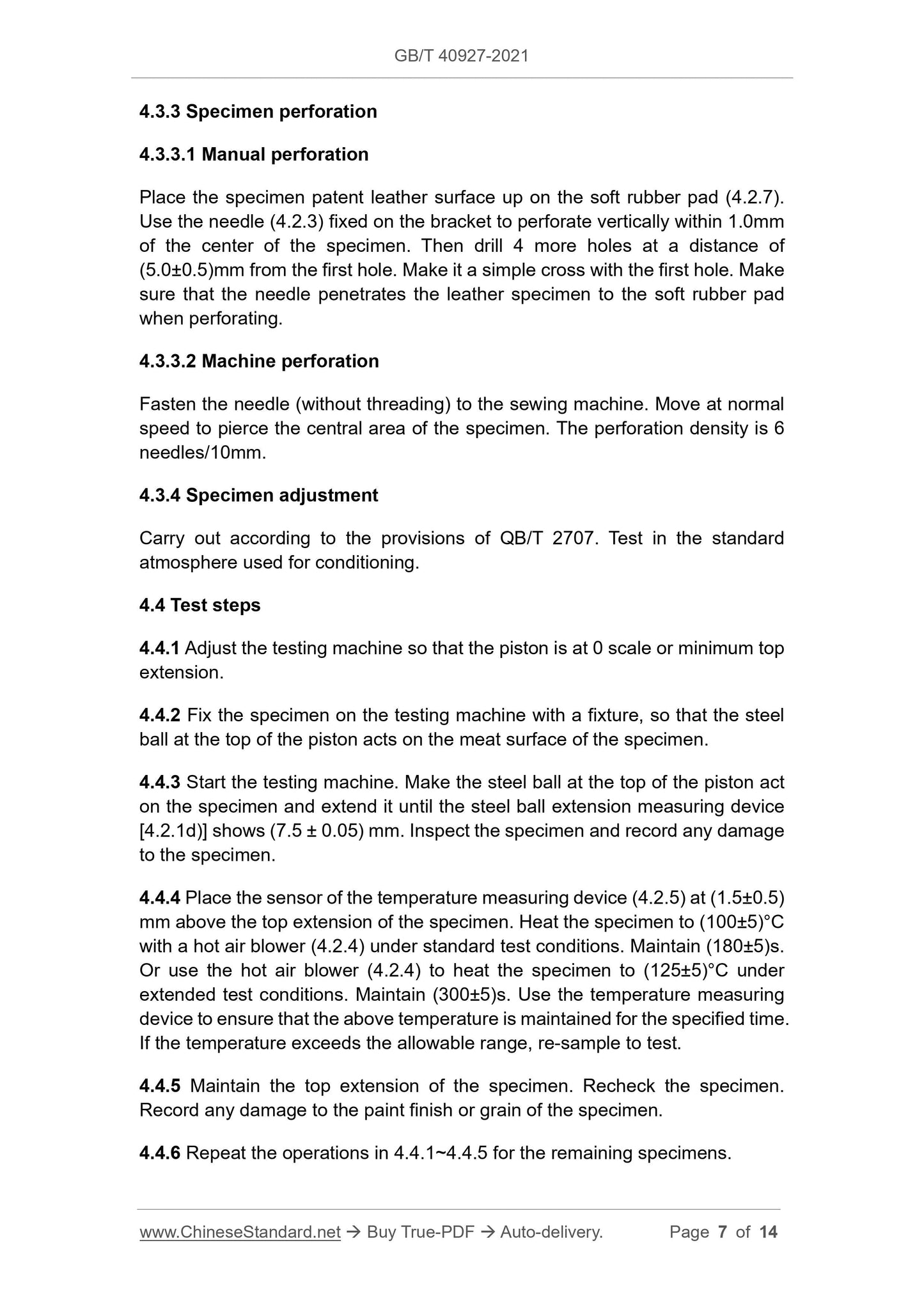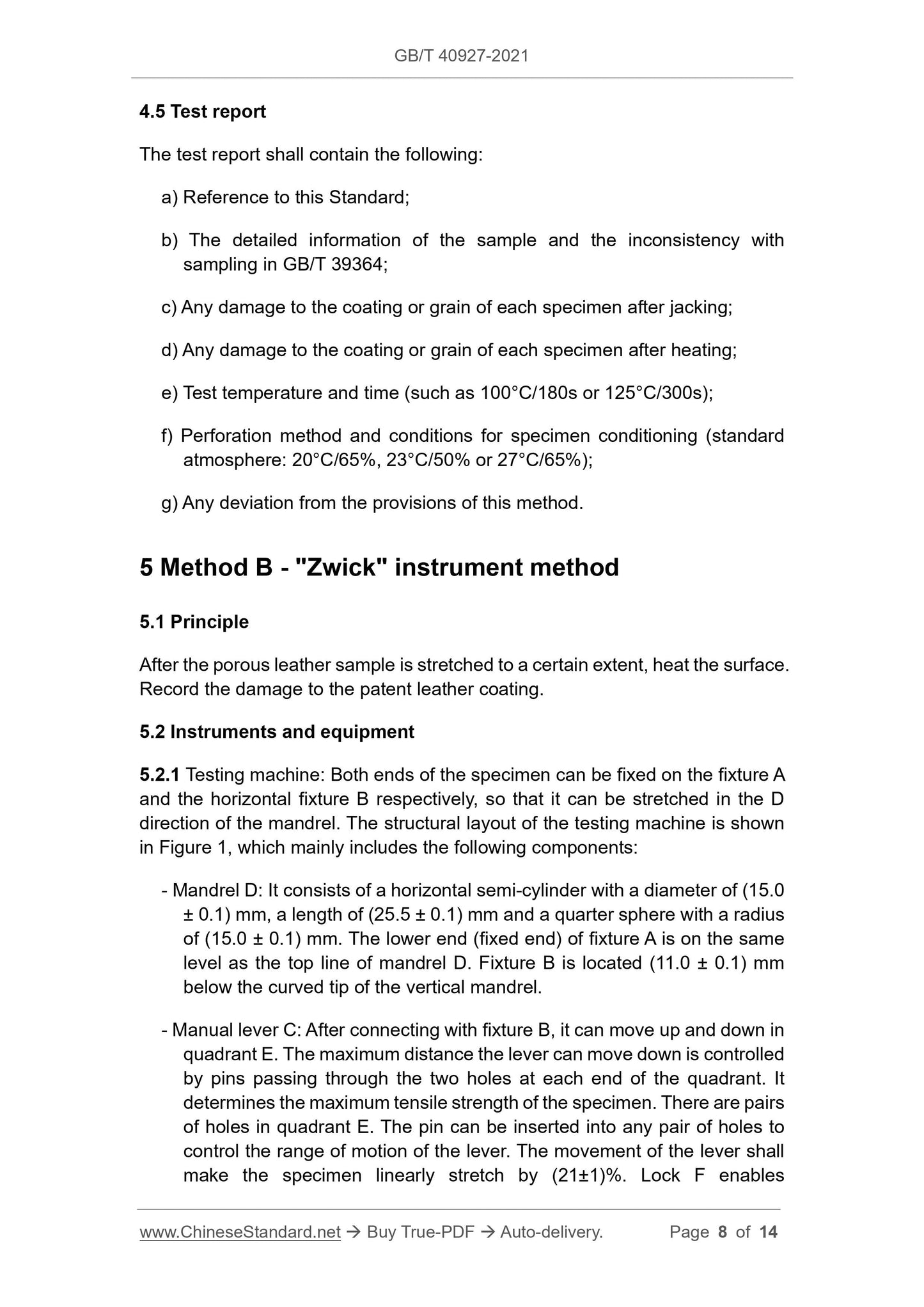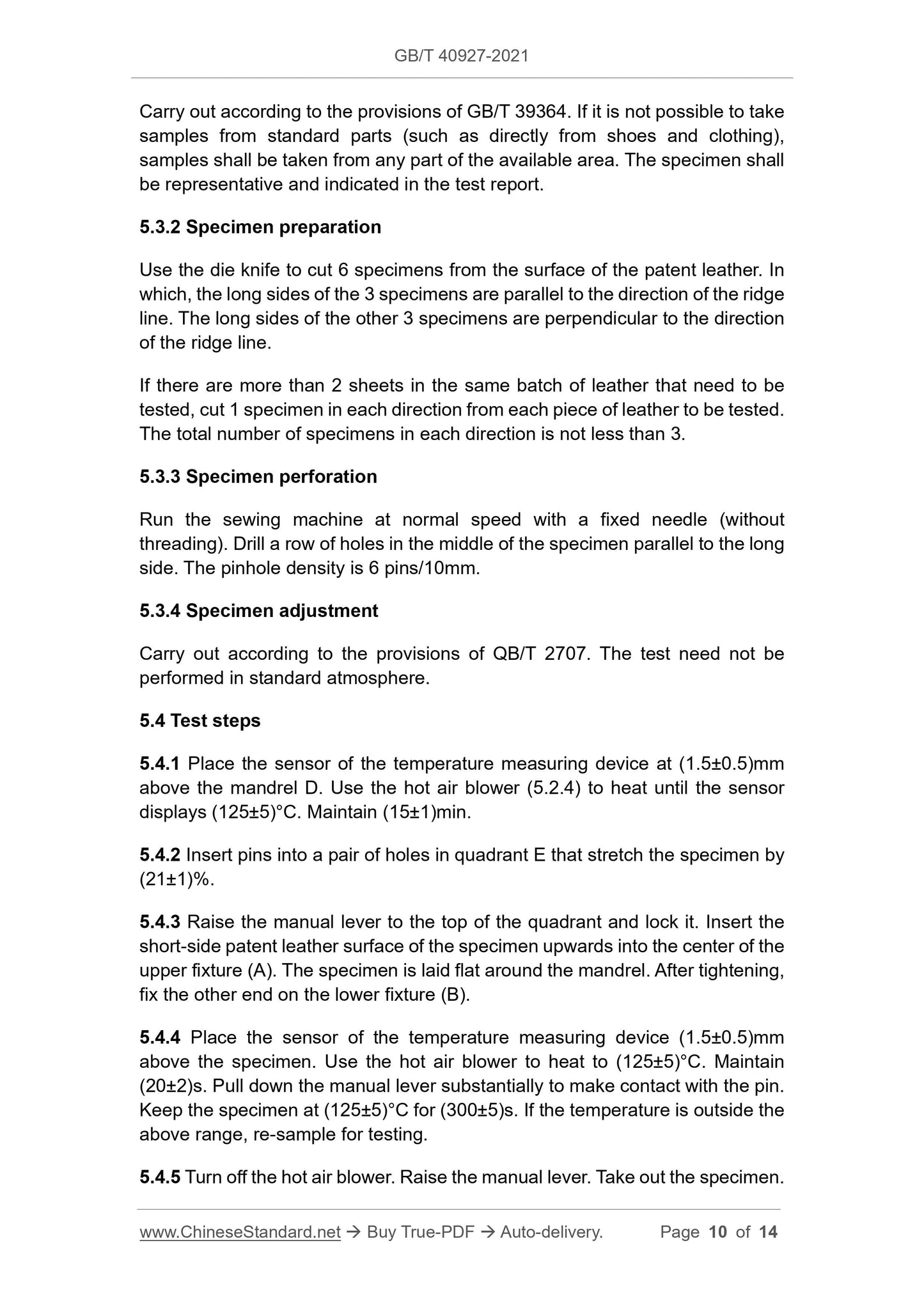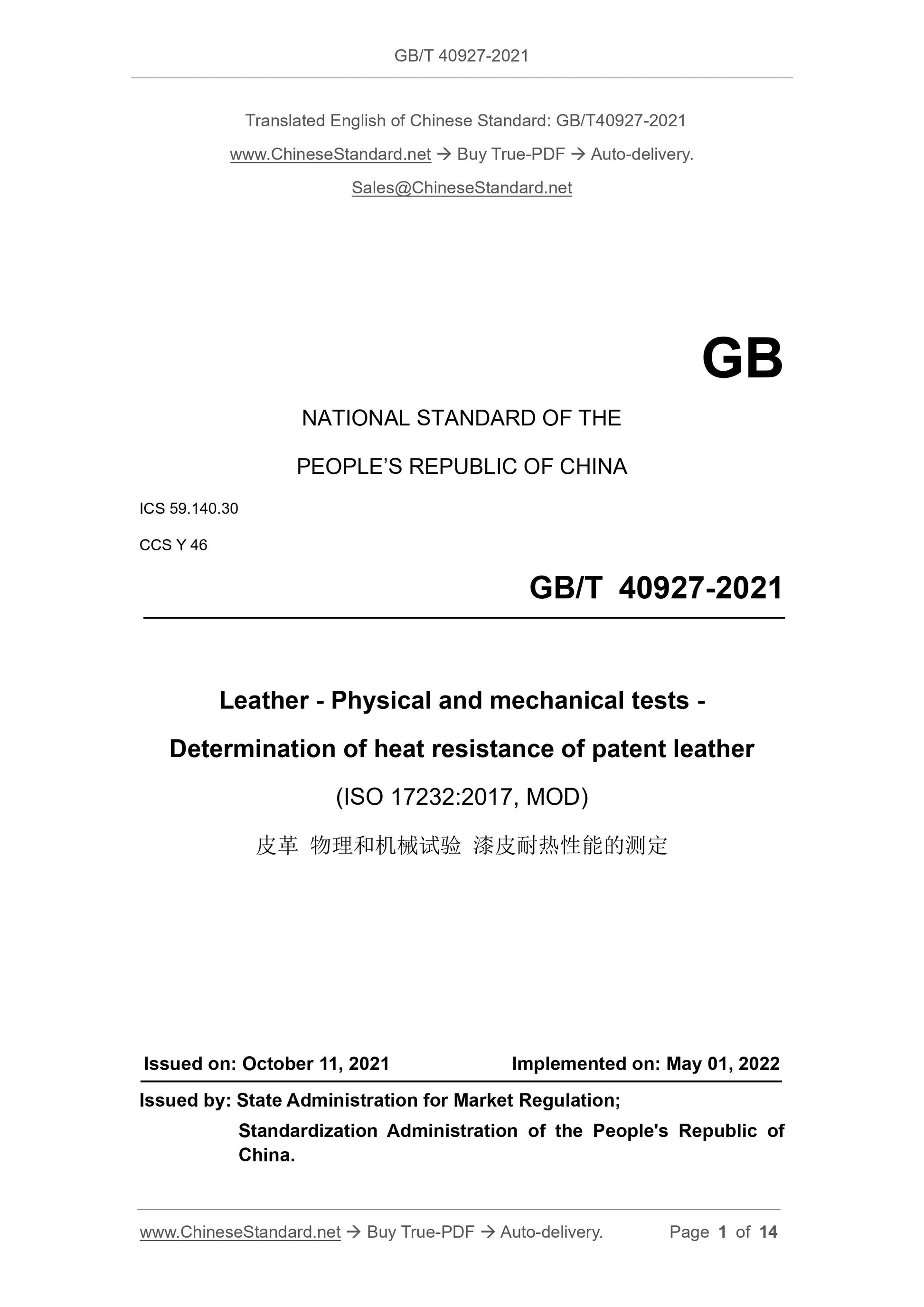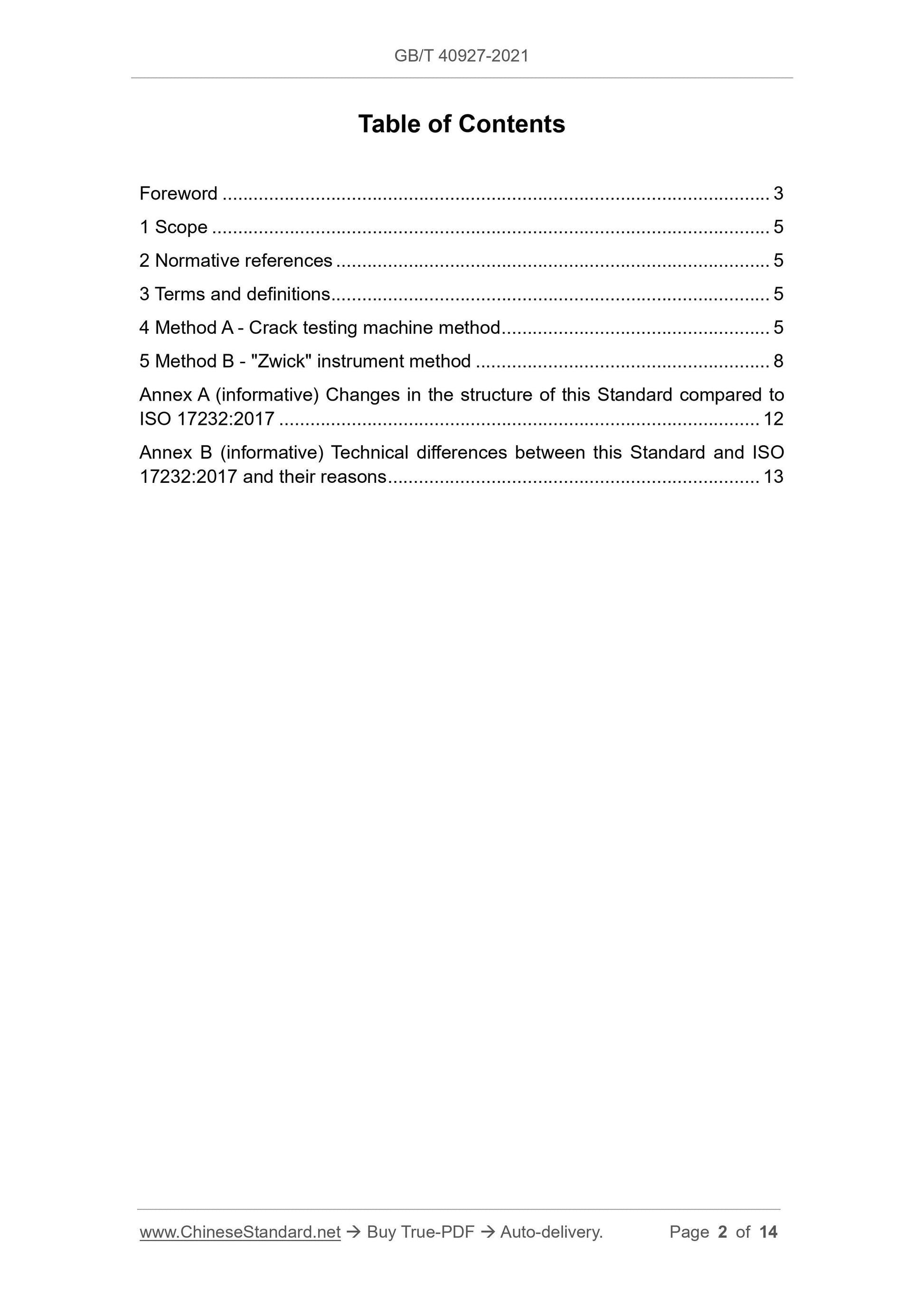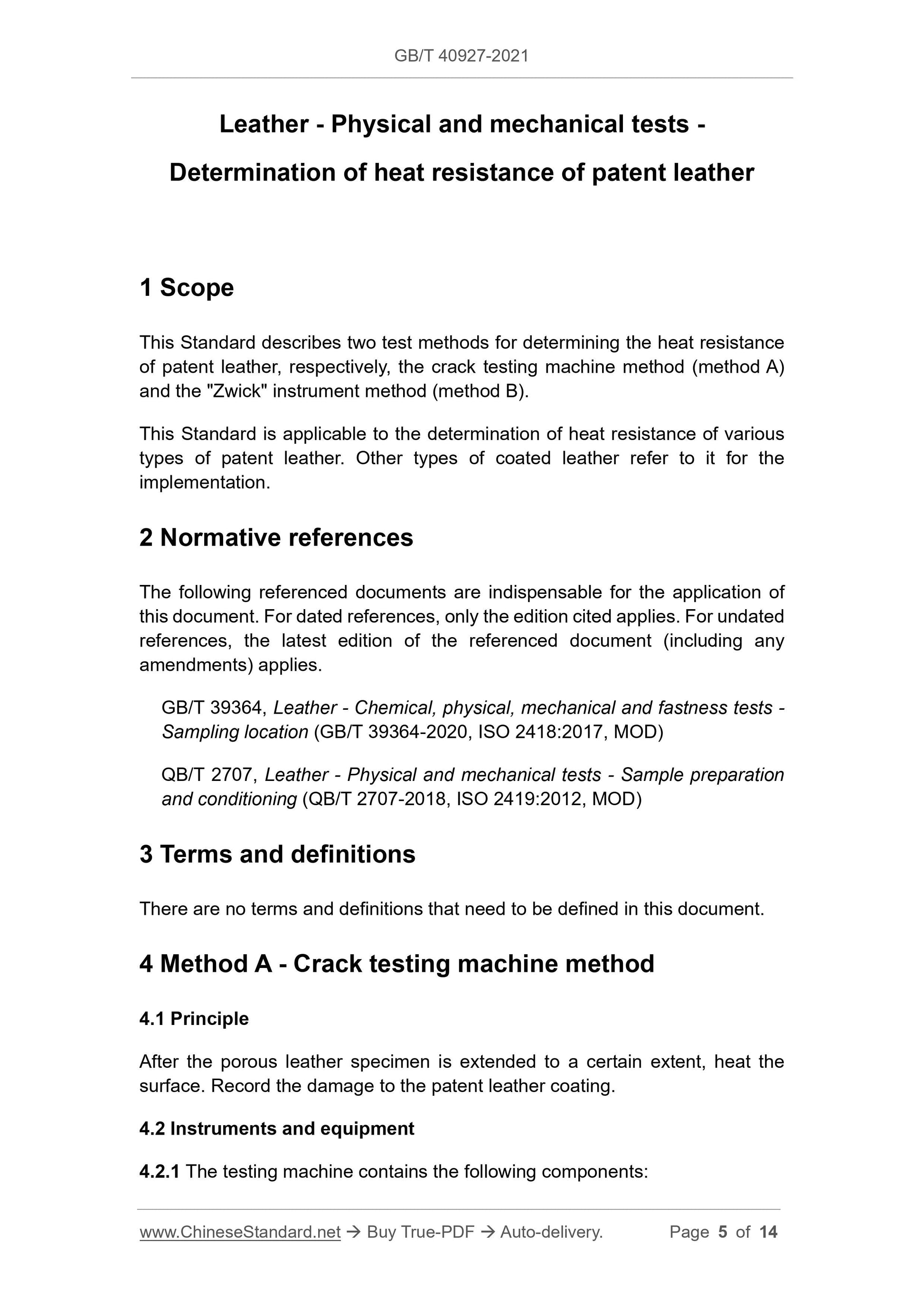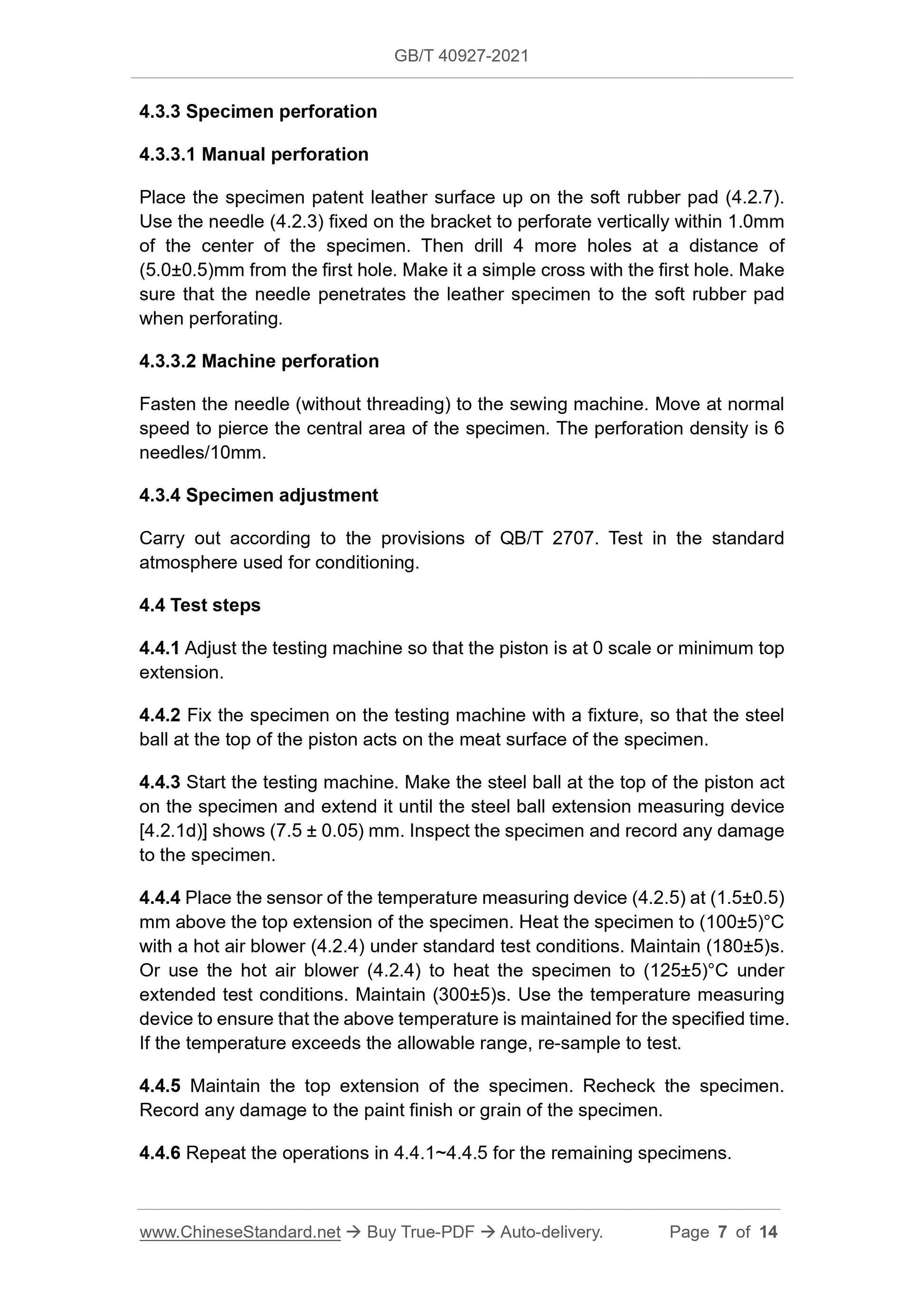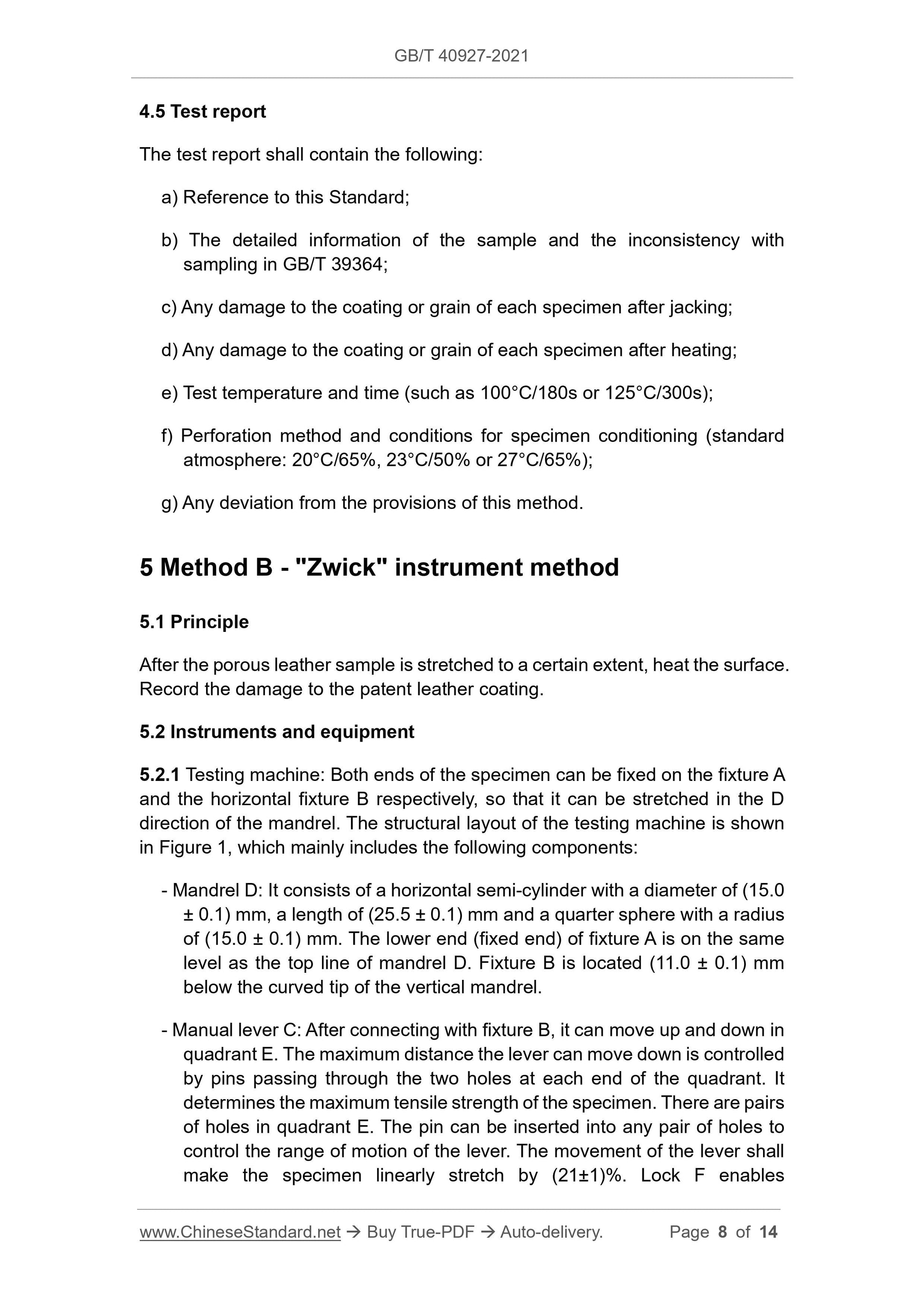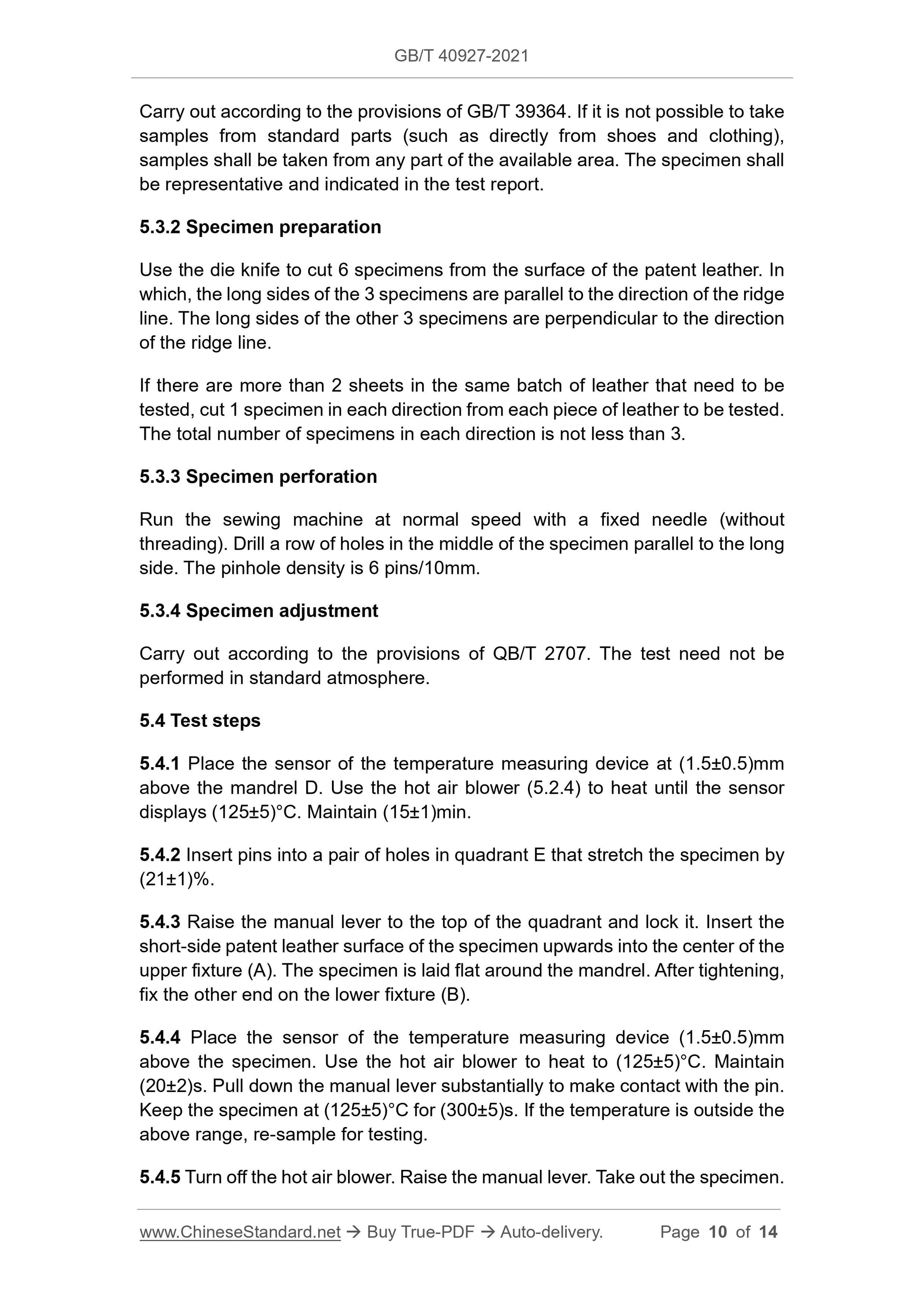1
/
of
6
www.ChineseStandard.us -- Field Test Asia Pte. Ltd.
GB/T 40927-2021 English PDF (GB/T40927-2021)
GB/T 40927-2021 English PDF (GB/T40927-2021)
Regular price
$185.00
Regular price
Sale price
$185.00
Unit price
/
per
Shipping calculated at checkout.
Couldn't load pickup availability
GB/T 40927-2021: Leather - Physical and mechanical tests - Determination of heat resistance of patent leather
Delivery: 9 seconds. Download (& Email) true-PDF + Invoice.
Get Quotation: Click GB/T 40927-2021 (Self-service in 1-minute)
Historical versions (Master-website): GB/T 40927-2021
Preview True-PDF (Reload/Scroll-down if blank)
GB/T 40927-2021
NATIONAL STANDARD OF THE
PEOPLE’S REPUBLIC OF CHINA
ICS 59.140.30
CCS Y 46
Leather - Physical and mechanical tests -
Determination of heat resistance of patent leather
(ISO 17232:2017, MOD)
ISSUED ON: OCTOBER 11, 2021
IMPLEMENTED ON: MAY 01, 2022
Issued by: State Administration for Market Regulation;
Standardization Administration of the People's Republic of
China.
Table of Contents
Foreword ... 3
1 Scope ... 5
2 Normative references ... 5
3 Terms and definitions ... 5
4 Method A - Crack testing machine method ... 5
5 Method B - "Zwick" instrument method ... 8
Annex A (informative) Changes in the structure of this Standard compared to
ISO 17232:2017 ... 12
Annex B (informative) Technical differences between this Standard and ISO
17232:2017 and their reasons ... 13
Leather - Physical and mechanical tests -
Determination of heat resistance of patent leather
1 Scope
This Standard describes two test methods for determining the heat resistance
of patent leather, respectively, the crack testing machine method (method A)
and the "Zwick" instrument method (method B).
This Standard is applicable to the determination of heat resistance of various
types of patent leather. Other types of coated leather refer to it for the
implementation.
2 Normative references
The following referenced documents are indispensable for the application of
this document. For dated references, only the edition cited applies. For undated
references, the latest edition of the referenced document (including any
amendments) applies.
GB/T 39364, Leather - Chemical, physical, mechanical and fastness tests -
Sampling location (GB/T 39364-2020, ISO 2418:2017, MOD)
QB/T 2707, Leather - Physical and mechanical tests - Sample preparation
and conditioning (QB/T 2707-2018, ISO 2419:2012, MOD)
3 Terms and definitions
There are no terms and definitions that need to be defined in this document.
4 Method A - Crack testing machine method
4.1 Principle
After the porous leather specimen is extended to a certain extent, heat the
surface. Record the damage to the patent leather coating.
4.2 Instruments and equipment
4.2.1 The testing machine contains the following components:
4.3.3 Specimen perforation
4.3.3.1 Manual perforation
Place the specimen patent leather surface up on the soft rubber pad (4.2.7).
Use the needle (4.2.3) fixed on the bracket to perforate vertically within 1.0mm
of the center of the specimen. Then drill 4 more holes at a distance of
(5.0±0.5)mm from the first hole. Make it a simple cross with the first hole. Make
sure that the needle penetrates the leather specimen to the soft rubber pad
when perforating.
4.3.3.2 Machine perforation
Fasten the needle (without threading) to the sewing machine. Move at normal
speed to pierce the central area of the specimen. The perforation density is 6
needles/10mm.
4.3.4 Specimen adjustment
Carry out according to the provisions of QB/T 2707. Test in the standard
atmosphere used for conditioning.
4.4 Test steps
4.4.1 Adjust the testing machine so that the piston is at 0 scale or minimum top
extension.
4.4.2 Fix the specimen on the testing machine with a fixture, so that the steel
ball at the top of the piston acts on the meat surface of the specimen.
4.4.3 Start the testing machine. Make the steel ball at the top of the piston act
on the specimen and extend it until the steel ball extension measuring device
[4.2.1d)] shows (7.5 ± 0.05) mm. Inspect the specimen and record any damage
to the specimen.
4.4.4 Place the sensor of the temperature measuring device (4.2.5) at (1.5±0.5)
mm above the top extension of the specimen. Heat the specimen to (100±5)°C
with a hot air blower (4.2.4) under standard test conditions. Maintain (180±5)s.
Or use the hot air blower (4.2.4) to heat the specimen to (125±5)°C under
extended test conditions. Maintain (300±5)s. Use the temperature measuring
device to ensure that the above temperature is maintained for the specified time.
If the temperature exceeds the allowable range, re-sample to test.
4.4.5 Maintain the top extension of the specimen. Recheck the specimen.
Record any damage to the paint finish or grain of the specimen.
4.4.6 Repeat the operations in 4.4.1~4.4.5 for the remaining specimens.
4.5 Test report
The test report shall contain the following:
a) Reference to this Standard;
b) The detailed information of the sample and the inconsistency with
sampling in GB/T 39364;
c) Any damage to the coating or grain of each specimen after jacking;
d) Any damage to the coating or grain of each specimen after heating;
e) Test temperature and time (such as 100°C/180s or 125°C/300s);
f) Perforation method and conditions for specimen conditioning (standard
atmosphere: 20°C/65%, 23°C/50% or 27°C/65%);
g) Any deviation from the provisions of this method.
5 Method B - "Zwick" instrument method
5.1 Principle
After the porous leather sample is stretched to a certain extent, heat the surface.
Record the damage to the patent leather coating.
5.2 Instruments and equipment
5.2.1 Testing machine: Both ends of the specimen can be fixed on the fixture A
and the horizontal fixture B respectively, so that it can be stretched in the D
direction of the mandrel. The structural layout of the testing machine is shown
in Figure 1, which mainly includes the following components:
- Mandrel D: It consists of a horizontal semi-cylinder with a diameter of (15.0
± 0.1) mm, a length of (25.5 ± 0.1) mm and a quarter sphere with a radius
of (15.0 ± 0.1) mm. The lower end (fixed end) of fixture A is on the same
level as the top line of mandrel D. Fixture B is located (11.0 ± 0.1) mm
below the curved tip of the vertical mandrel.
- Manual lever C: After connecting with fixture B, it can move up and down in
quadrant E. The maximum distance the lever can move down is controlled
by pins passing through the two holes at each end of the quadrant. It
determines the maximum tensile strength of the specimen. There are pairs
of holes in quadrant E. The pin can be inserted into any pair of holes to
control the range of motion of the lever. The movement of the lever shall
make the specimen linearly stretch by (21±1)%. Lock F enables
Carry out according to the provisions of GB/T 39364. If it is not possible to take
samples from standard parts (such as directly from shoes and clothing),
samples shall be taken from any part of the available area. The specimen shall
be representative and indicated in the test report.
5.3.2 Specimen preparation
Use the die knife to cut 6 specimens from the surface of the patent leather. In
which, the long sides of the 3 specimens are parallel to the direction of the ridge
line. The long sides of the other 3 specimens are perpendicular to the direction
of the ridge line.
If there are more than 2 sheets in the same batch of leather that need to be
tested, cut 1 specimen in each direction from each piece of leather to be tested.
The total number of specimens in each direction is not less than 3.
5.3.3 Specimen perforation
Run the sewing machine at normal speed with a fixed needle (without
threading). Drill a row of holes in the middle of the specimen parallel to the long
side. The pinhole density is 6 pins/10mm.
5.3.4 Specimen adjustment
Carry out according to the provisions of QB/T 2707. The test need not be
performed in standard atmosphere.
5.4 Test steps
5.4.1 Place the sensor of the temperature measuring device at (1.5±0.5)mm
above the mandrel D. Use the hot air blower (5.2.4) to heat until the sensor
displays (125±5)°C. Maintain (15±1)min.
5.4.2 Insert pins into a pair of holes in quadrant E that stretch the specimen by
(21±1)%.
5.4.3 Raise the manual lever to the top of the quadrant and lock it. Insert the
short-side patent leather surface of the specimen upwards into the center of the
upper fixture (A). The specimen is laid flat around the mandrel. After tightening,
fix the other end on the lower fixture (B).
5.4.4 Place the sensor of the temperature measuring device (1.5±0.5)mm
above the specimen. Use the hot air blower to heat to (125±5)°C. Maintain
(20±2)s. Pull down the manual lever substantially to make contact with the pin.
Keep the specimen at (125±5)°C for (300±5)s. If the temperature is outside the
above range, re-sample for testing.
5.4.5 Turn off the hot air blower. Raise the manual lever. Take out the specimen.
GB/T 40927-2021
NATIONAL STANDARD OF THE
PEOPLE’S REPUBLIC OF CHINA
ICS 59.140.30
CCS Y 46
Leather - Physical and mechanical tests -
Determination of heat resistance of patent leather
(ISO 17232:2017, MOD)
ISSUED ON: OCTOBER 11, 2021
IMPLEMENTED ON: MAY 01, 2022
Issued by: State Administration for Market Regulation;
Standardization Administration of the People's Republic of
China.
Table of Contents
Foreword ... 3
1 Scope ... 5
2 Normative references ... 5
3 Terms and definitions ... 5
4 Method A - Crack testing machine method ... 5
5 Method B - "Zwick" instrument method ... 8
Annex A (informative) Changes in the structure of this Standard compared to
ISO 17232:2017 ... 12
Annex B (informative) Technical differences between this Standard and ISO
17232:2017 and their reasons ... 13
Leather - Physical and mechanical tests -
Determination of heat resistance of patent leather
1 Scope
This Standard describes two test methods for determining the heat resistance
of patent leather, respectively, the crack testing machine method (method A)
and the "Zwick" instrument method (method B).
This Standard is applicable to the determination of heat resistance of various
types of patent leather. Other types of coated leather refer to it for the
implementation.
2 Normative references
The following referenced documents are indispensable for the application of
this document. For dated references, only the edition cited applies. For undated
references, the latest edition of the referenced document (including any
amendments) applies.
GB/T 39364, Leather - Chemical, physical, mechanical and fastness tests -
Sampling location (GB/T 39364-2020, ISO 2418:2017, MOD)
QB/T 2707, Leather - Physical and mechanical tests - Sample preparation
and conditioning (QB/T 2707-2018, ISO 2419:2012, MOD)
3 Terms and definitions
There are no terms and definitions that need to be defined in this document.
4 Method A - Crack testing machine method
4.1 Principle
After the porous leather specimen is extended to a certain extent, heat the
surface. Record the damage to the patent leather coating.
4.2 Instruments and equipment
4.2.1 The testing machine contains the following components:
4.3.3 Specimen perforation
4.3.3.1 Manual perforation
Place the specimen patent leather surface up on the soft rubber pad (4.2.7).
Use the needle (4.2.3) fixed on the bracket to perforate vertically within 1.0mm
of the center of the specimen. Then drill 4 more holes at a distance of
(5.0±0.5)mm from the first hole. Make it a simple cross with the first hole. Make
sure that the needle penetrates the leather specimen to the soft rubber pad
when perforating.
4.3.3.2 Machine perforation
Fasten the needle (without threading) to the sewing machine. Move at normal
speed to pierce the central area of the specimen. The perforation density is 6
needles/10mm.
4.3.4 Specimen adjustment
Carry out according to the provisions of QB/T 2707. Test in the standard
atmosphere used for conditioning.
4.4 Test steps
4.4.1 Adjust the testing machine so that the piston is at 0 scale or minimum top
extension.
4.4.2 Fix the specimen on the testing machine with a fixture, so that the steel
ball at the top of the piston acts on the meat surface of the specimen.
4.4.3 Start the testing machine. Make the steel ball at the top of the piston act
on the specimen and extend it until the steel ball extension measuring device
[4.2.1d)] shows (7.5 ± 0.05) mm. Inspect the specimen and record any damage
to the specimen.
4.4.4 Place the sensor of the temperature measuring device (4.2.5) at (1.5±0.5)
mm above the top extension of the specimen. Heat the specimen to (100±5)°C
with a hot air blower (4.2.4) under standard test conditions. Maintain (180±5)s.
Or use the hot air blower (4.2.4) to heat the specimen to (125±5)°C under
extended test conditions. Maintain (300±5)s. Use the temperature measuring
device to ensure that the above temperature is maintained for the specified time.
If the temperature exceeds the allowable range, re-sample to test.
4.4.5 Maintain the top extension of the specimen. Recheck the specimen.
Record any damage to the paint finish or grain of the specimen.
4.4.6 Repeat the operations in 4.4.1~4.4.5 for the remaining specimens.
4.5 Test report
The test report shall contain the following:
a) Reference to this Standard;
b) The detailed information of the sample and the inconsistency with
sampling in GB/T 39364;
c) Any damage to the coating or grain of each specimen after jacking;
d) Any damage to the coating or grain of each specimen after heating;
e) Test temperature and time (such as 100°C/180s or 125°C/300s);
f) Perforation method and conditions for specimen conditioning (standard
atmosphere: 20°C/65%, 23°C/50% or 27°C/65%);
g) Any deviation from the provisions of this method.
5 Method B - "Zwick" instrument method
5.1 Principle
After the porous leather sample is stretched to a certain extent, heat the surface.
Record the damage to the patent leather coating.
5.2 Instruments and equipment
5.2.1 Testing machine: Both ends of the specimen can be fixed on the fixture A
and the horizontal fixture B respectively, so that it can be stretched in the D
direction of the mandrel. The structural layout of the testing machine is shown
in Figure 1, which mainly includes the following components:
- Mandrel D: It consists of a horizontal semi-cylinder with a diameter of (15.0
± 0.1) mm, a length ...
Delivery: 9 seconds. Download (& Email) true-PDF + Invoice.
Get Quotation: Click GB/T 40927-2021 (Self-service in 1-minute)
Historical versions (Master-website): GB/T 40927-2021
Preview True-PDF (Reload/Scroll-down if blank)
GB/T 40927-2021
NATIONAL STANDARD OF THE
PEOPLE’S REPUBLIC OF CHINA
ICS 59.140.30
CCS Y 46
Leather - Physical and mechanical tests -
Determination of heat resistance of patent leather
(ISO 17232:2017, MOD)
ISSUED ON: OCTOBER 11, 2021
IMPLEMENTED ON: MAY 01, 2022
Issued by: State Administration for Market Regulation;
Standardization Administration of the People's Republic of
China.
Table of Contents
Foreword ... 3
1 Scope ... 5
2 Normative references ... 5
3 Terms and definitions ... 5
4 Method A - Crack testing machine method ... 5
5 Method B - "Zwick" instrument method ... 8
Annex A (informative) Changes in the structure of this Standard compared to
ISO 17232:2017 ... 12
Annex B (informative) Technical differences between this Standard and ISO
17232:2017 and their reasons ... 13
Leather - Physical and mechanical tests -
Determination of heat resistance of patent leather
1 Scope
This Standard describes two test methods for determining the heat resistance
of patent leather, respectively, the crack testing machine method (method A)
and the "Zwick" instrument method (method B).
This Standard is applicable to the determination of heat resistance of various
types of patent leather. Other types of coated leather refer to it for the
implementation.
2 Normative references
The following referenced documents are indispensable for the application of
this document. For dated references, only the edition cited applies. For undated
references, the latest edition of the referenced document (including any
amendments) applies.
GB/T 39364, Leather - Chemical, physical, mechanical and fastness tests -
Sampling location (GB/T 39364-2020, ISO 2418:2017, MOD)
QB/T 2707, Leather - Physical and mechanical tests - Sample preparation
and conditioning (QB/T 2707-2018, ISO 2419:2012, MOD)
3 Terms and definitions
There are no terms and definitions that need to be defined in this document.
4 Method A - Crack testing machine method
4.1 Principle
After the porous leather specimen is extended to a certain extent, heat the
surface. Record the damage to the patent leather coating.
4.2 Instruments and equipment
4.2.1 The testing machine contains the following components:
4.3.3 Specimen perforation
4.3.3.1 Manual perforation
Place the specimen patent leather surface up on the soft rubber pad (4.2.7).
Use the needle (4.2.3) fixed on the bracket to perforate vertically within 1.0mm
of the center of the specimen. Then drill 4 more holes at a distance of
(5.0±0.5)mm from the first hole. Make it a simple cross with the first hole. Make
sure that the needle penetrates the leather specimen to the soft rubber pad
when perforating.
4.3.3.2 Machine perforation
Fasten the needle (without threading) to the sewing machine. Move at normal
speed to pierce the central area of the specimen. The perforation density is 6
needles/10mm.
4.3.4 Specimen adjustment
Carry out according to the provisions of QB/T 2707. Test in the standard
atmosphere used for conditioning.
4.4 Test steps
4.4.1 Adjust the testing machine so that the piston is at 0 scale or minimum top
extension.
4.4.2 Fix the specimen on the testing machine with a fixture, so that the steel
ball at the top of the piston acts on the meat surface of the specimen.
4.4.3 Start the testing machine. Make the steel ball at the top of the piston act
on the specimen and extend it until the steel ball extension measuring device
[4.2.1d)] shows (7.5 ± 0.05) mm. Inspect the specimen and record any damage
to the specimen.
4.4.4 Place the sensor of the temperature measuring device (4.2.5) at (1.5±0.5)
mm above the top extension of the specimen. Heat the specimen to (100±5)°C
with a hot air blower (4.2.4) under standard test conditions. Maintain (180±5)s.
Or use the hot air blower (4.2.4) to heat the specimen to (125±5)°C under
extended test conditions. Maintain (300±5)s. Use the temperature measuring
device to ensure that the above temperature is maintained for the specified time.
If the temperature exceeds the allowable range, re-sample to test.
4.4.5 Maintain the top extension of the specimen. Recheck the specimen.
Record any damage to the paint finish or grain of the specimen.
4.4.6 Repeat the operations in 4.4.1~4.4.5 for the remaining specimens.
4.5 Test report
The test report shall contain the following:
a) Reference to this Standard;
b) The detailed information of the sample and the inconsistency with
sampling in GB/T 39364;
c) Any damage to the coating or grain of each specimen after jacking;
d) Any damage to the coating or grain of each specimen after heating;
e) Test temperature and time (such as 100°C/180s or 125°C/300s);
f) Perforation method and conditions for specimen conditioning (standard
atmosphere: 20°C/65%, 23°C/50% or 27°C/65%);
g) Any deviation from the provisions of this method.
5 Method B - "Zwick" instrument method
5.1 Principle
After the porous leather sample is stretched to a certain extent, heat the surface.
Record the damage to the patent leather coating.
5.2 Instruments and equipment
5.2.1 Testing machine: Both ends of the specimen can be fixed on the fixture A
and the horizontal fixture B respectively, so that it can be stretched in the D
direction of the mandrel. The structural layout of the testing machine is shown
in Figure 1, which mainly includes the following components:
- Mandrel D: It consists of a horizontal semi-cylinder with a diameter of (15.0
± 0.1) mm, a length of (25.5 ± 0.1) mm and a quarter sphere with a radius
of (15.0 ± 0.1) mm. The lower end (fixed end) of fixture A is on the same
level as the top line of mandrel D. Fixture B is located (11.0 ± 0.1) mm
below the curved tip of the vertical mandrel.
- Manual lever C: After connecting with fixture B, it can move up and down in
quadrant E. The maximum distance the lever can move down is controlled
by pins passing through the two holes at each end of the quadrant. It
determines the maximum tensile strength of the specimen. There are pairs
of holes in quadrant E. The pin can be inserted into any pair of holes to
control the range of motion of the lever. The movement of the lever shall
make the specimen linearly stretch by (21±1)%. Lock F enables
Carry out according to the provisions of GB/T 39364. If it is not possible to take
samples from standard parts (such as directly from shoes and clothing),
samples shall be taken from any part of the available area. The specimen shall
be representative and indicated in the test report.
5.3.2 Specimen preparation
Use the die knife to cut 6 specimens from the surface of the patent leather. In
which, the long sides of the 3 specimens are parallel to the direction of the ridge
line. The long sides of the other 3 specimens are perpendicular to the direction
of the ridge line.
If there are more than 2 sheets in the same batch of leather that need to be
tested, cut 1 specimen in each direction from each piece of leather to be tested.
The total number of specimens in each direction is not less than 3.
5.3.3 Specimen perforation
Run the sewing machine at normal speed with a fixed needle (without
threading). Drill a row of holes in the middle of the specimen parallel to the long
side. The pinhole density is 6 pins/10mm.
5.3.4 Specimen adjustment
Carry out according to the provisions of QB/T 2707. The test need not be
performed in standard atmosphere.
5.4 Test steps
5.4.1 Place the sensor of the temperature measuring device at (1.5±0.5)mm
above the mandrel D. Use the hot air blower (5.2.4) to heat until the sensor
displays (125±5)°C. Maintain (15±1)min.
5.4.2 Insert pins into a pair of holes in quadrant E that stretch the specimen by
(21±1)%.
5.4.3 Raise the manual lever to the top of the quadrant and lock it. Insert the
short-side patent leather surface of the specimen upwards into the center of the
upper fixture (A). The specimen is laid flat around the mandrel. After tightening,
fix the other end on the lower fixture (B).
5.4.4 Place the sensor of the temperature measuring device (1.5±0.5)mm
above the specimen. Use the hot air blower to heat to (125±5)°C. Maintain
(20±2)s. Pull down the manual lever substantially to make contact with the pin.
Keep the specimen at (125±5)°C for (300±5)s. If the temperature is outside the
above range, re-sample for testing.
5.4.5 Turn off the hot air blower. Raise the manual lever. Take out the specimen.
GB/T 40927-2021
NATIONAL STANDARD OF THE
PEOPLE’S REPUBLIC OF CHINA
ICS 59.140.30
CCS Y 46
Leather - Physical and mechanical tests -
Determination of heat resistance of patent leather
(ISO 17232:2017, MOD)
ISSUED ON: OCTOBER 11, 2021
IMPLEMENTED ON: MAY 01, 2022
Issued by: State Administration for Market Regulation;
Standardization Administration of the People's Republic of
China.
Table of Contents
Foreword ... 3
1 Scope ... 5
2 Normative references ... 5
3 Terms and definitions ... 5
4 Method A - Crack testing machine method ... 5
5 Method B - "Zwick" instrument method ... 8
Annex A (informative) Changes in the structure of this Standard compared to
ISO 17232:2017 ... 12
Annex B (informative) Technical differences between this Standard and ISO
17232:2017 and their reasons ... 13
Leather - Physical and mechanical tests -
Determination of heat resistance of patent leather
1 Scope
This Standard describes two test methods for determining the heat resistance
of patent leather, respectively, the crack testing machine method (method A)
and the "Zwick" instrument method (method B).
This Standard is applicable to the determination of heat resistance of various
types of patent leather. Other types of coated leather refer to it for the
implementation.
2 Normative references
The following referenced documents are indispensable for the application of
this document. For dated references, only the edition cited applies. For undated
references, the latest edition of the referenced document (including any
amendments) applies.
GB/T 39364, Leather - Chemical, physical, mechanical and fastness tests -
Sampling location (GB/T 39364-2020, ISO 2418:2017, MOD)
QB/T 2707, Leather - Physical and mechanical tests - Sample preparation
and conditioning (QB/T 2707-2018, ISO 2419:2012, MOD)
3 Terms and definitions
There are no terms and definitions that need to be defined in this document.
4 Method A - Crack testing machine method
4.1 Principle
After the porous leather specimen is extended to a certain extent, heat the
surface. Record the damage to the patent leather coating.
4.2 Instruments and equipment
4.2.1 The testing machine contains the following components:
4.3.3 Specimen perforation
4.3.3.1 Manual perforation
Place the specimen patent leather surface up on the soft rubber pad (4.2.7).
Use the needle (4.2.3) fixed on the bracket to perforate vertically within 1.0mm
of the center of the specimen. Then drill 4 more holes at a distance of
(5.0±0.5)mm from the first hole. Make it a simple cross with the first hole. Make
sure that the needle penetrates the leather specimen to the soft rubber pad
when perforating.
4.3.3.2 Machine perforation
Fasten the needle (without threading) to the sewing machine. Move at normal
speed to pierce the central area of the specimen. The perforation density is 6
needles/10mm.
4.3.4 Specimen adjustment
Carry out according to the provisions of QB/T 2707. Test in the standard
atmosphere used for conditioning.
4.4 Test steps
4.4.1 Adjust the testing machine so that the piston is at 0 scale or minimum top
extension.
4.4.2 Fix the specimen on the testing machine with a fixture, so that the steel
ball at the top of the piston acts on the meat surface of the specimen.
4.4.3 Start the testing machine. Make the steel ball at the top of the piston act
on the specimen and extend it until the steel ball extension measuring device
[4.2.1d)] shows (7.5 ± 0.05) mm. Inspect the specimen and record any damage
to the specimen.
4.4.4 Place the sensor of the temperature measuring device (4.2.5) at (1.5±0.5)
mm above the top extension of the specimen. Heat the specimen to (100±5)°C
with a hot air blower (4.2.4) under standard test conditions. Maintain (180±5)s.
Or use the hot air blower (4.2.4) to heat the specimen to (125±5)°C under
extended test conditions. Maintain (300±5)s. Use the temperature measuring
device to ensure that the above temperature is maintained for the specified time.
If the temperature exceeds the allowable range, re-sample to test.
4.4.5 Maintain the top extension of the specimen. Recheck the specimen.
Record any damage to the paint finish or grain of the specimen.
4.4.6 Repeat the operations in 4.4.1~4.4.5 for the remaining specimens.
4.5 Test report
The test report shall contain the following:
a) Reference to this Standard;
b) The detailed information of the sample and the inconsistency with
sampling in GB/T 39364;
c) Any damage to the coating or grain of each specimen after jacking;
d) Any damage to the coating or grain of each specimen after heating;
e) Test temperature and time (such as 100°C/180s or 125°C/300s);
f) Perforation method and conditions for specimen conditioning (standard
atmosphere: 20°C/65%, 23°C/50% or 27°C/65%);
g) Any deviation from the provisions of this method.
5 Method B - "Zwick" instrument method
5.1 Principle
After the porous leather sample is stretched to a certain extent, heat the surface.
Record the damage to the patent leather coating.
5.2 Instruments and equipment
5.2.1 Testing machine: Both ends of the specimen can be fixed on the fixture A
and the horizontal fixture B respectively, so that it can be stretched in the D
direction of the mandrel. The structural layout of the testing machine is shown
in Figure 1, which mainly includes the following components:
- Mandrel D: It consists of a horizontal semi-cylinder with a diameter of (15.0
± 0.1) mm, a length ...
Share
